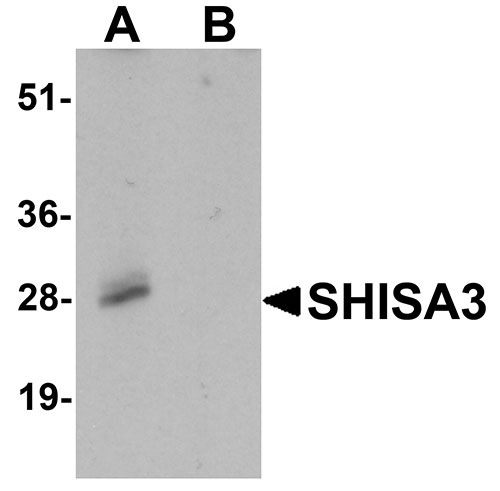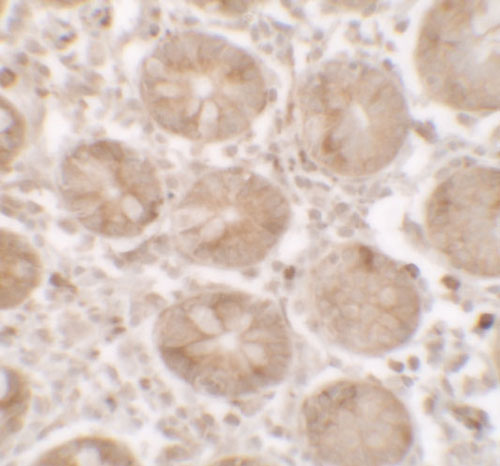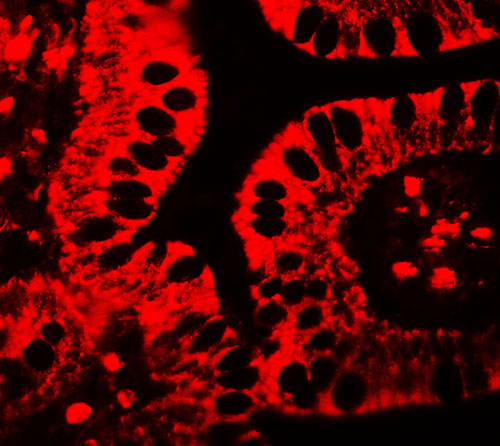SHISA3 Antibody
- 产品详情
- 实验流程
- 背景知识
Application
| WB, IF, E, IHC-P |
|---|---|
| Primary Accession | A0PJX4 |
| Other Accession | NP_001073974, 122937450 |
| Reactivity | Human, Mouse, Rat |
| Host | Rabbit |
| Clonality | Polyclonal |
| Isotype | IgG |
| Calculated MW | 25832 Da |
| Concentration (mg/ml) | 1 mg/mL |
| Conjugate | Unconjugated |
| Application Notes | SHISA3 Antibody can be used for detection of SHISA3 by Western blot at 1 µg/mL. |
| Gene ID | 152573 |
|---|---|
| Other Names | Protein shisa-3 homolog, SHISA3 |
| Target/Specificity | SHISA3; SHISA3 antibody is predicted to not cross-react with other SHISA protein family members. |
| Reconstitution & Storage | SHISA3 antibody can be stored at 4℃ for three months and -20℃, stable for up to one year. |
| Precautions | SHISA3 Antibody is for research use only and not for use in diagnostic or therapeutic procedures. |
| Name | SHISA3 |
|---|---|
| Function | Plays an essential role in the maturation of presomitic mesoderm cells by individual attenuation of both FGF and WNT signaling. |
| Cellular Location | Endoplasmic reticulum membrane {ECO:0000250, ECO:0000250|UniProtKB:Q7T0Z7}; Single-pass type I membrane protein {ECO:0000250|UniProtKB:Q7T0Z7} |
For Research Use Only. Not For Use In Diagnostic Procedures.
Provided below are standard protocols that you may find useful for product applications.
BACKGROUND
SHISA3 Antibody: SHISA3 plays an essential role in the maturation of presomitic mesoderm cells by individual attenuation of both FGF and WNT signaling. The Shisa family of single-transmembrane proteins is characterized by an N-terminal cysteine-rich domain and a proline-rich C-terminal region. Its founding member, Xenopus Shisa, promotes head development by antagonizing Wnt and FGF signaling. Shisa physically interacted with immature forms of the Wnt receptor Frizzled and the FGF receptor within the ER and inhibited their posttranslational maturation and trafficking to the cell surface. Loss of Shisa function sensitized the neuroectoderm to Wnt signaling and suppressed head formation during gastrulation.
REFERENCES
Furushima K, Yamamoto A, Nagano T, et al. Mouse homologues of Shisa antagonistic to Wnt and Fgf signalings. Dev. Biol. 2007; 306:480-92.
Pei J and Grishin NV. Unexpected diversity in Shisa-like proteins suggests the importance of their roles as transmembrane adaptors. Cell Signal. 2012; 24:758-69.
Yamamoto A, Nagano T, Takehara S, et al. Shisa promotes head formation through the inhibition of receptor protein maturation for the caudalizing factors, Wnt and FGF. Cell 2005; 120:223-35
终于等到您。ABCEPTA(百远生物)抗体产品。
点击下方“我要评价 ”按钮提交您的反馈信息,您的反馈和评价是我们最宝贵的财富之一,
我们将在1-3个工作日内处理您的反馈信息。
如有疑问,联系:0512-88856768 tech-china@abcepta.com.























 癌症的基本特征包括细胞增殖、血管生成、迁移、凋亡逃避机制和细胞永生等。找到癌症发生过程中这些通路的关键标记物和对应的抗体用于检测至关重要。
癌症的基本特征包括细胞增殖、血管生成、迁移、凋亡逃避机制和细胞永生等。找到癌症发生过程中这些通路的关键标记物和对应的抗体用于检测至关重要。 为您推荐一个泛素化位点预测神器——泛素化分析工具,可以为您的蛋白的泛素化位点作出预测和评分。
为您推荐一个泛素化位点预测神器——泛素化分析工具,可以为您的蛋白的泛素化位点作出预测和评分。 细胞自噬受体图形绘图工具为你的蛋白的细胞受体结合位点作出预测和评分,识别结合到自噬通路中的蛋白是非常重要的,便于让我们理解自噬在正常生理、病理过程中的作用,如发育、细胞分化、神经退化性疾病、压力条件下、感染和癌症。
细胞自噬受体图形绘图工具为你的蛋白的细胞受体结合位点作出预测和评分,识别结合到自噬通路中的蛋白是非常重要的,便于让我们理解自噬在正常生理、病理过程中的作用,如发育、细胞分化、神经退化性疾病、压力条件下、感染和癌症。








